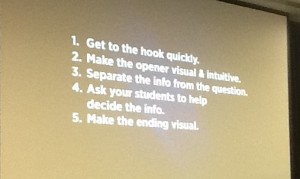CAPTURE PERPLEXITY – do we?
SHARE PERPLEXITY – do we?
RESOLVE PERPLEXITY – do we?
If you are looking for some inspiration and ideas to capture the imaginations and attention of your students, look no further than to Dan Meyer (@ddmeyer, blog.mrmeyer.com). Oh, you say, but he is a maths specialist. I beg to differ! He is a student specialist who happens to teach maths (or math as they say in the US). I am actually NOT a maths teacher, but the highlight of Saturday’s sessions for me was the fact that I got to spend most of it with Dan. (Ha, first name basis now). Listening, engaging and learning – and I would have to say – from one of the best practioners I have ever had the pleasure of learning from.
What Dan focused on was the fact that what we need to do as educators – teaching middle school or other – is to capture curiosity in our students. To do that, we need to be capturing perplexity, constantly. See something that needs solving – take a photo of it, record it. Need to teach something, anything; then find some visual (or similar) that will capture the perplexity of the students, that will peak their curiosity, that will make them want to SOLVE that problem, or EXPLORE it further. We talk about wanting inquiring minds, then we need to offer the opportunity for our students to inquire. Let them “work out” what it is they need to solve that rather perplexing question, let them RESOLVE PERPLEXITY.
The two hour workshop with Dan led us through a typical maths lesson – Dan Style – one that I totally engaged with. No textbook in sight; constant collaboration, discussion and challenge, and hands on and relevant. Who would have known at the beginning of the lesson, that in actual fact we were learning about the volume of cylinders? No objective on the board to begin, but once completed, a question to us – What do you think the focus of this lesson has been? That strategy, (one which I will certainly use) really provokes some thinking, and provides the feedback needed to reinforce the effectiveness of the lesson. Of course, being intelligent thinking adults, we could definitely answer that question, and I would fathom that most students would have been able to as well.
We did not have to navigate some wordy, irrelevant problem in a maths text book that students have no connection with – you know, “A farmer in Arizona is growing grain, and every year he stores his grain in silos. This particular year, he had a bumper crop, so had to invest in another silo. So he installed a slightly narrower one, that was shorter, and positioned it right next to the other one. At the end of the season, they are both half filled , etc, etc” Oh, and then there is a black and white diagram with dimensions on each figure and really just looks like two cylinders, etc, etc……
Hey, I don’t live in the country, so what the? What is this about grain? Who cares if he had a bumper crop, and where he lived, and so on.
We were simply shown two different shaped glasses of coke, and the statement – that I have to share with my sister. Which one would I give her? End of story! Well, appealing to our sense of greed, we clearly need to take the fullest one – but wait, which one would that be? And so the lesson continued. Firslty we had to guess, you know, gut reaction, but then the lesson progressed.
We weren’t on our own, there was a clear process, and Dan took us through it step by step, modelling, then deconstructing the process. What can I say? This was excellent. There were no “losers” in the class, only success stories. I guess that with maths lessons like this, we could certainly change many a student perception of what maths is. Unfortunately for many, the experience of maths is a text book, and sadly, many of those books are quite flawed.
So through a Maths lesson, I was inspired to think about my own approaches and to consider what perplexity I could capture. I will certainly be ensuring that my Perplexity Fairy stays firmly on my shoulder, so that I continue to seek those moments, both in school and more importantly, out of school that could well become a lesson starter for my next class – you never really know when something you see or hear will present itself.
Dan’s link for MYSA Conference to resources and ideas.

